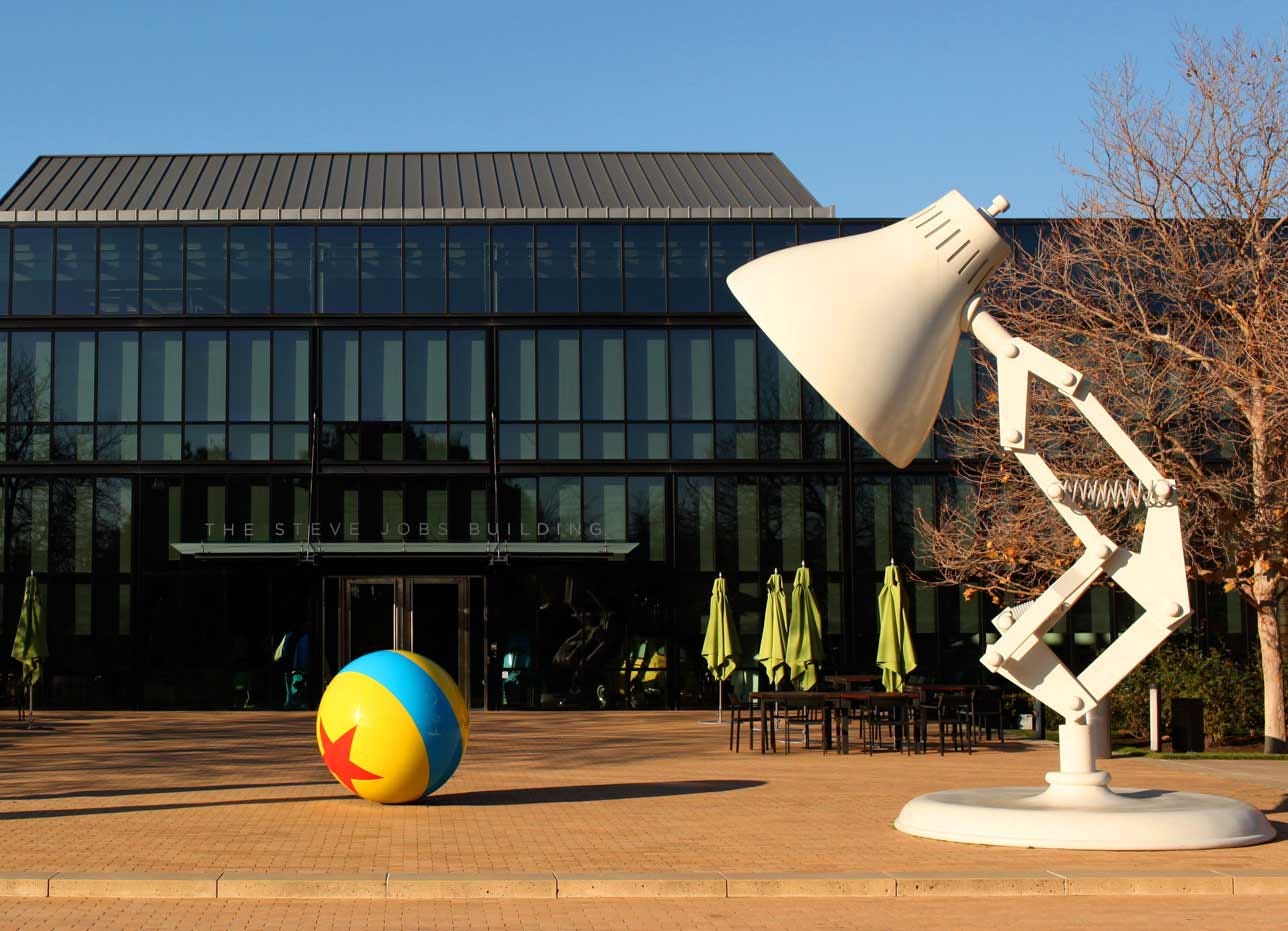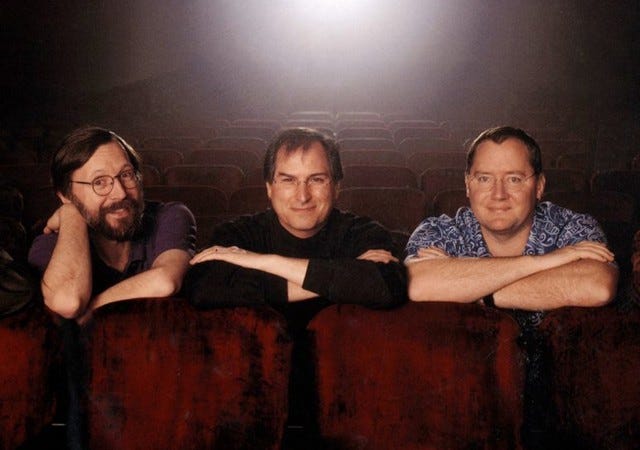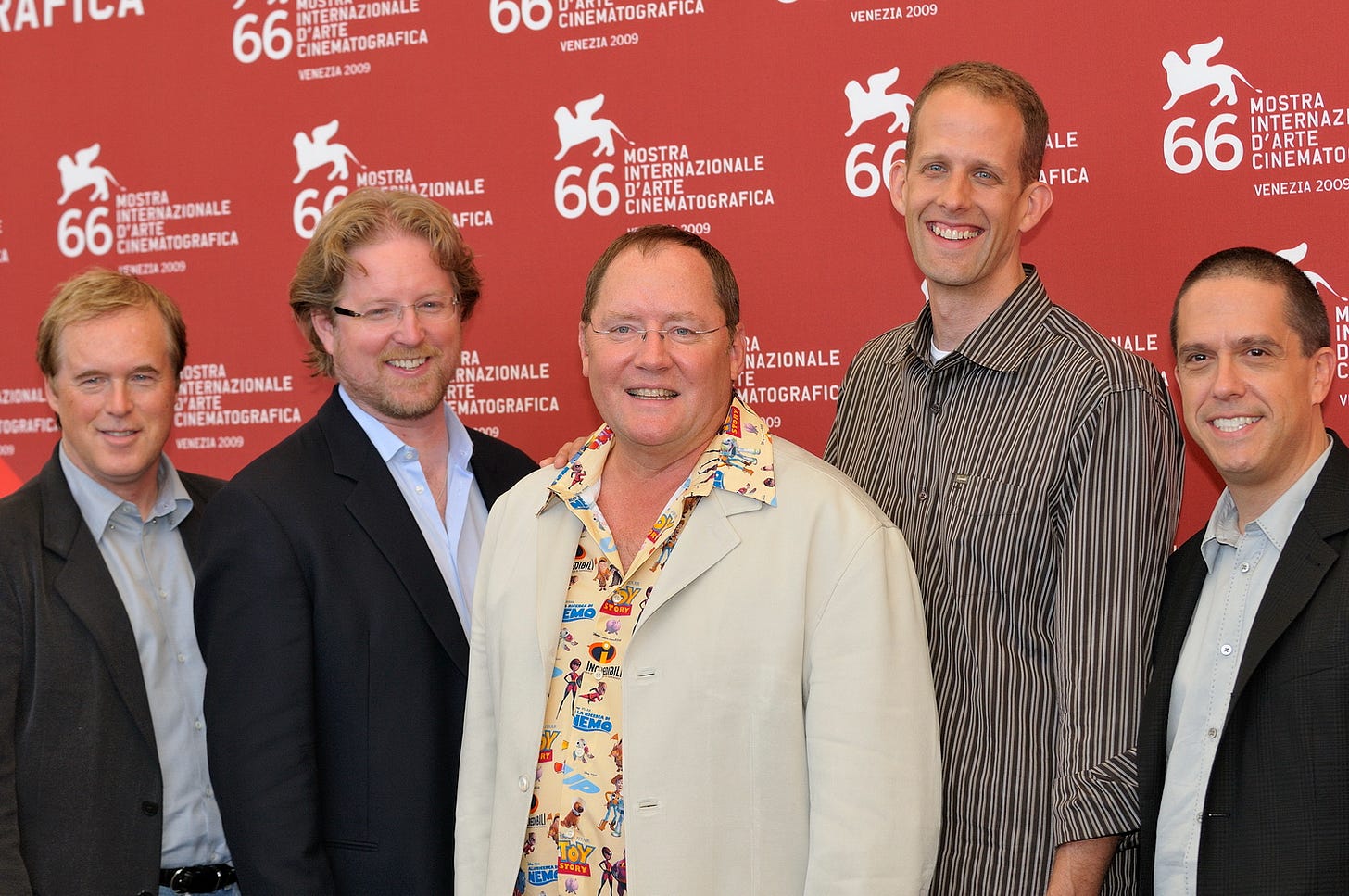A Bump in the Road or the End of Pixar’s Golden Age?
A look at Pixar’s history and the rise of new animation studios.
Thanks for joining my newsletter The Screen where I talk about the art of media and business. If you’ve got any suggestions, I’d love to hear them. Otherwise stay safe, wear a mask, and hopefully we can all go to the movies soon, enjoy!
Pixar. Just the word evokes a certain admiration and for good reason. It’s consistently ranked amongst the top companies that people want to work for. Also many people think Pixar is synonymous with animation. My friends will mistakenly call a Disney film a Pixar film and like the nerd I am I’m compelled to tell them “actually it’s a Pixar film.” From the release of Toy Story in 1995 to the years after, Pixar has been on top and for the most part is still there. Yet… now it feels different. Multiple friends have asked me “What happened to Pixar?” After a perfect run of movies they released Cars 2, Brave, and The Good Dinosaur, all received less than stellar ratings. Also after only one sequel (Toy Story 2), Pixar released a slew of sequels. If you look at the Annie Awards (the Oscars for animation) Pixar won six times for Best animated feature from 2000 to 2010 but only twice from 2010 to 2020. So what happened? Well to start let’s look at Pixar’s history.

History of Pixar
Pixar was “founded” as a graphic division under Lucasfilm by Ed Catmull & Alvy Ray Smith. I put quotes because the Pixar that we know and love was truly founded in 1986 when Lucasfilm spun off Pixar. The main founders that most people give credit to are Ed Catmull, Steve Jobs (who bought Pixar from Lucasfilm), and John Lasseter (the master storyteller behind many of the early films). All three of these people are no longer with the company – Steve Job’s passed away in 2011, John Lasseter’s left due to sexual misconduct in 2018, and Ed Catmull retired in 2019.

The three cofounders - Ed Catmull (left), Steve Jobs (center), John Lasseter (right).
I could associate these losses with the decrease in Pixar’s quality (and it might be true). but besides John Lasseter they did not make up the core of Pixar’s creative storytelling. The core storytelling ‘Braintrust’ consisted of John Lasseter, Lee Unkrich, Joe Ranft, Andrew Stanton, Pete Docter, and Brad Bird (pictured below).

Only Pete Docter fully remains at Pixar (he’s the tall one)
Joe Ranft passed away in 2005, Lee Unkrich retired in 2019, Andrew Stanton has been spending more time doing live action/non-pixar work, and Brad Bird is working on an upcoming musical not affiliated with Pixar. To say that these losses are significant is an understatement. The core of any creative company are the people – even above IP. Ed Catmull says it himself in his book Creativity Inc. – “If you give a good idea to a mediocre team, they will screw it up. If you give a mediocre idea to a brilliant team, they will either fix it or throw it away and come up with something better.” With the founders and core of Pixar gone, it’s easy to assume that this is the cause of their problems. However, it’s important to look externally, as the animation industry has changed significantly since Pixar’s founding.
Animation Industry – A Brief Look
Animation has been around for over a century, starting with comics and ending with the wide range of styles we have today. While Pixar and Disney are top of mind when it comes to animation, newer studios have made the animation industry more competitive. Here’s an overview on who’s a threat to Pixar and who’s not.
Rising Competitors
Sony Animation Studios: Founded almost 20 years ago, the studio had a rocky start. It was almost sold off until the success of Monsters Inc. and Shrek showed Sony that animation studios could be lucrative. While they don’t always hit the mark (Emoji Movie, Angry Birds) they have had success with Cloudy With a Chance of Meatballs and Hotel Transylvania. Most recently Sony made Spiderman Into the Spider Verse, which took home the Oscar for Best Animated Feature. This movie not only had a diverse cast and fantastic story, but had a whole new style of animation. To me this shows Sony is willing to put resources to be creative and different. I expect more of this in their future.
Netflix: When Netflix debuted their first original programming House of Cards seven years ago, it shocked the industry as a whole. Years later Netflix is continuing their disruption in the animation industry. In 2015 netflix bought The Little Prince from Paramount. In 2019, they released their first animated original production Klaus, which won the Annie Award for Best Animated Feature (and should've won the Oscar but got snubbed). Netflix is like Sony where they are not afraid to be different and are stacking their culture with talent. Sanjay Patel and Frank Abney both Pixar veterans have moved over Netflix to create animated projects. Others include Shannon Tindle from Laika (writer of Kubo and the Two Strings), Disney animation legend Glen Keane, and Jorge Guiterrez (director of Book of Life). Netflix had the culture, resources, and now creative talent. With this combination, Netflix Animation studios is a serious threat to Pixar.
Disney Animation: No introduction here as Disney brought animation to households across the world. Though they've had weak periods, Disney is once again experiencing period of success. Ironically this is only after Pixar veterans came in and changed the culture in 2005. Since then they've released hits like Tangled, Frozen, Zootopia, and more. All the films since 2005 (except for Frozen II and Ralph Breaks the Internet) are original films that span a wide range of genres. Pixar might have saved Disney initially but now it’s created one of its biggest competitors.
Mild Competition
Illumination: Founded in 2007 by Chris Meledandri (an ex-20th Century Fox/Blue Sky executive), it is the newest studio I am going to talk about today. This studio is most known for it’s Despicable Me franchise but has other hits including Sing and The Secret Life of Pets. While their ratings have been average or below average, their box office has been a success with two films making over $1 billion. As they continue to expand their franches, they also have a partnership with Nintendo for an upcoming Mario film. Illumination has built a strong fan base that mostly caters to a younger audience. Their future production pipeline suggests they have no plans to change this focus. Because of this, Illumination does not pose a significant threat to Pixar in terms of quality and genre.
Dreamworks: Founded in 1996, Dreamworks has been the primarily rivals to Disney/Pixar in 3D animation. Things started off strong with Shrek, which won the first Oscar given for Best Animated Feature. They've continued to find success in franchises like How to Train Your Dragon, Kung Fu Panda, and Madagascar. Yet their ratings have been average and not a single film has crossed 1B at the worldwide box office (Shrek 2 is the closest with 920M and Disney/Pixar have a combined 7). With HTTYD trilogy ended and other franchises milked to the bone, Dreamworks needs to find new IP and talent if it wants to rise. Also, they were acquired by Universal Studios (who also own Illumination) and now must set themselves apart much like Disney and Pixar. Dreamworks is teetering on the edge, but they've historically been some of the biggest competition to Pixar and wouldn’t count them out yet.
Little to no Threat
Warner Animation Group: Warner Studios entered feature animation in the early 90’s. The released the critically acclaimed movie The Iron Giant directed by Brad Bird (yes the same one that moved to Pixar). The studio took a hiatus and came back in 2014. Since then they've released average movies (Storks) mixed with great movies (Lego Movie). Their upcoming slate does not have significant franchises, however they do include classics like Tom and Jerry andThe Flintstones. With these classics they could pose a threat but currently it’s minor. EDIT. Literally as I was finishing this article it was announced that Warner Animation Group would be making three new Dr. Suess movies, including one based off of Oh, the Places You’ll go! With this information I would move up Warner to the middle category.
Laika: Oh Laika, how I wanted you to be great. It’s bankrolled by Nike founder Phil Knight and run by his son Travis Knight. They’ve had fantastic films including Caroline, The Boxtrolls, and Kubo and the Two Strings – yet they’re falling. Their failure is the abysmal box office performance (highest gross is $125 million). This can partly be attributed to release timing and marketing. Whatever the reason, poor performances and the pandemic have led to them lay off a significant amount of employees. Other animation studios are having a boom during the pandemic, Laika, which uses stop motion animation, can’t work from home as effectively. Hopefully they can fix their problems as I adore the stop motion and stories they’ve put forward but for now they’re not a threat.
Blue Sky: Blue Sky, founded in the 1980’s, is one of the older animation studios on this list. They initially focused on commercial work before moving into feature animation with their hit Ice Age. Unfortunately their early success didn't continue and have released average movies since then. They are now a subsidiary under Disney (Disney bought 20th Fox Century). I put them in this category because there’s only one upcoming slated picture for Blue Sky studios and little is known about what is going to happen next. Will Disney keep the small Connecticut studio almost 3000 miles from its headquarters running? It’s unclear, but even if they were to continue and make content for Disney+, I don’t expect Disney to turn around Blue Sky like Pixar did for Disney.
When Pixar first created Toy Story there were few if any studios competing for the top. Now, 25 years later, the field is much more crowded and Pixar must adapt to both internal and external pressures. What can Pixar do? Well, here’s a list of 3 actions Pixar can take to remain at the top.
3 Steps for Pixar
Branch out of 3D animation: Pixar invented the 3D animated feature so this would be a big leap – but hear me out. Pixar has already tried new styles of animation with their shorts Blue Umbrella and Piper, so they have the technology. Pixar, however, has been reluctant to try these techniques for a feature. This has left Pixar vulnerable to other studios creating new animation styles – Sony’s Spiderman Into the Spider Verse and Netflix’s Klaus – both won praise from a variety of critics. So what’s stopping them? Well one reason might be that Ed Catmul and John Lasseter's already tried to revive 2D animation at Disney (Princess and the Frog) and it failed. Another could be that Pixar is intentionally not trying new animation, leaving the space for Disney. Regardless of the reason, I think it’s in Pixar’s best interest to take risks and try new styles of animation, whether that be 2D or new techniques in 3D.
Series: This is a bit obvious – television series have skyrocketed in the last decade and Pixar already has small shows like Forky Asks a Question. I’m not talking about small scale though, Pixar needs to dedicate large resources to make this switch. While things like budgeting will have to be hashed out, the most critical challenge for Pixar will be taking their mastery of storytelling from 90 minute features and translating this for series. Thankfully there’s a model for this. Marvel, another Disney subsidiary, initially focused on creating films for the last decade and a half. Now they’re splitting their talent between films and series, but keeping the same quality. Some of you are thinking wait what about the Marvel series on Netflix and ABC? Yes yes Marvel did create those series but they were not a core focus nor did they carry the same budgets. Marvel is now dedicating a large amount of resources to Falcon and the Winter Soldier, with the talent saying it feels just like a Marvel film. Pixar should follow this lead. First by keeping the quality the same for their series. In a sense Pixar has already done this. They famously tried to make Toy Story 2 a direct to video sequel but found that they couldn’t intentionally make a bad film. Second, Pixar should talk with Marvel’s writers and story heads to figure out how they expand arcs beyond 90 minutes. If Pixar can translate their feature success to series, they would once again be at the top with no one close.
Global Approach: The world is becoming more global so studios should follow suit. It sounds really simple and in theory it should be. Tell stories from around the globe for audiences around the world – but it’s not really practiced. Cinema historically has focused on telling stories from an American (and Western Europe) POV. This is also true for animation, including Pixar. “Hey but Pixar made Coco and it was amazing.” Coco is a fantastic example of this, however it’s the only film in Pixar’s history to feature a POC main character (yes Soul is coming out... eventually) and also the only movie set in a non-western setting. I don’t agree that all studios can tell stories from across the world but Pixar’s research and story development process along with diverse crew members behind the scenes tell me they will succeed – only if they try.
So is it a bump in a road? Pixar has had a lot of internal bumps and while there’s a bit more external competition now, it’ll take more than this for it to fall from the top. For Pixar to remain at the top however, they need to pivot and once again set the standards for premier animation and storytelling.
Thanks for reading and let me know what you think! Always love to hear feedback on current/past articles as well as suggestions for future topics.
About Me (Harnek)
I’m a screenwriter and media lover. I graduated from University of Michigan in 2015 with a degree in film. Took a quick detour going to medical school (also at Umich) but now I’m back in the media/business world.
I Listened to these soundtracks while writing this post.
Inside Out - Composed by Michael Giacchino
Beauty and the Beast - Composed by Alan Menkin



